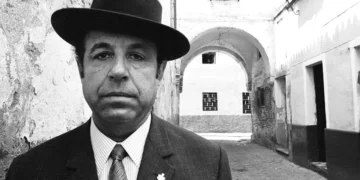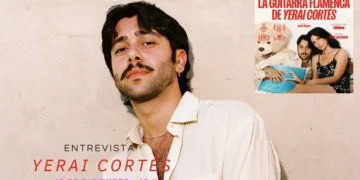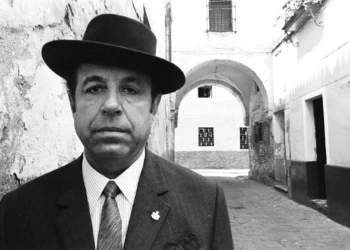|
Dance: Cristina Hoyos, El Junco. Bailaoras: Susana Casas, Cristina
Gallego, Rosa Belmonte, María del Mar Moreno, Rocío
Alcaide, Lucía Guamido, Zaira Santos. Coros de ballet: José
Luis Vidal, Jesús Ortega, Jacob Guerrero, Javier Crespo,
Daniel Torres, Abel Harana, Juan A. Jiménez. Singers: Reyes
Martín, Vicente Gelo, Miguel Rosendo. Guitarists: Andrés
Martínez, Ramón Amador. Percussion: Roberto Carlos
Jaén.
Text: Estela Zatania
Under the direccion of Cristina Hoyos, the Ballet Flamenco
de Andalucía, formerly known as the Compañía
Andaluza de Danza, came to the Villamarta Theater in Jerez with
its latest work “Viaje al Sur”. Premiered in March 2005
at Cordoba’s Gran Teatro, passing through the Málaga
en Flamenco festival and presented at New York’s City Center
as part of a promotional campaign sponsored by the Andalusian Ministry
of Tourism, Commerce and Sports, the extravagant show finally came
to the toughest venue of all, managing to fill about two thirds
of the seats in the venerable theater.
The show’s scope, its specific aspirations and the generous
budget did not augure well for profound moments of great subtlety,
but little by little we’re learning to assimilate each flamenco
manifestation without an excess of intellectual or nostalgic baggage.
The curtain goes up to reveal the entire company, stock still and
staring out into the audience. The silence is broken by the voice
of Cristina Hoyos who requests a minute of silence in honor of master
choreographer José Granero who passed away just a few hours
earlier. This sober and unexpected opening was the introduction
for the first of three movements which make up “Viaje al Sur”.
The trio of voices manages to get just
the right blend of traditional and contemporary
Manuela Vargas may have been the first dancer to explore the concept
of groups of related dances – tonás with siguiriya
with serranas, alegrías with romeras with mirabrá,
soleá with romance with caña – over forty years
ago when an adolescent Cristina Hoyos was a member of the company.
In Viaje al Sur, Hoyos reworks the idea with a show that aims to
express “La Alegría”, “La Tragedia”
and “La Pasión” through dances, music and colores
which share a certain affinity.
With a wardrobe in tones of peaches and cream, pale violet, honey
and milk, the first movement is a delicious celebration of uncomplicated
pleasure expressed via a flamenco waltz in major key, guajira, zapateado
and alegrías. Cristina takes on some chuflas, the humorous
half-spoken half-sung form in pure Cádiz style, but the sassy
attitude so important for pulling it off, escapes her. No matter,
we’re content to appreciate the visuals, the compás
and the best of intentions. In this block of dances, el Junco is
outstanding with his alegrías, the only strong solo dance
in the entire work. He serves up polished technique and an impeccable
style but we’re left wishing he’d deviate from the rigid
script to see what his svelte figure is capable of. The singers
are not great stars, but highly competent and the trio of voices
manages to get just the right blend of traditional and contemporary.
Good visuals, compás and the
best of intentions
The trip changes direction and color and we enter into a world
of grey and black to evoke “La Tragedia”, a sort of
jondo-suite that includes soleá, soleá por bulería,
tonás and flashes of serrranas. A brief free-style introduction
by Cristina leads into group dances that begin to be tiresome. The
trick of “many bodies moving as one” gets old very quickly
and you long to see something, anything other than seven females
and seven males exhibiting their ability to surpress their personalities
for the common good. The tedium is aggravated by a certain sparseness
of vocals. The most noteworthy event was when the entire corps de
ballet appeared playing castanets, a percussive element in danger
of extinction ever since it became fashionable to reject anything
which might possibly be interpreted as “corny”. Perhaps
it’s not too late to also bring back the bata de cola as an
requisite accessory for female dancers.
Relief might have come with “La Pasión”, the
red portion of the show, but the momentum of the first movement
is never recuperated. The audience delights with “Gracias
a la Vida” to bulerías as recorded by María
Jiménez years ago, and Alejandro Sanz’ “Corazón
Partío” to tangos produces a collective spasm of delight
to nearly end the show. All that’s left is the meticulously
choreographed fiesta finale which belies its own function as improvised
curtain call.
The bottom line is “Viaje al Sur” is a professional,
visually rich, well-prepared piece of work, free of emotion and
apt for all audiences.























